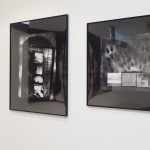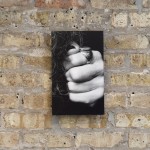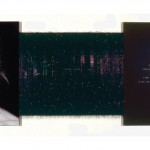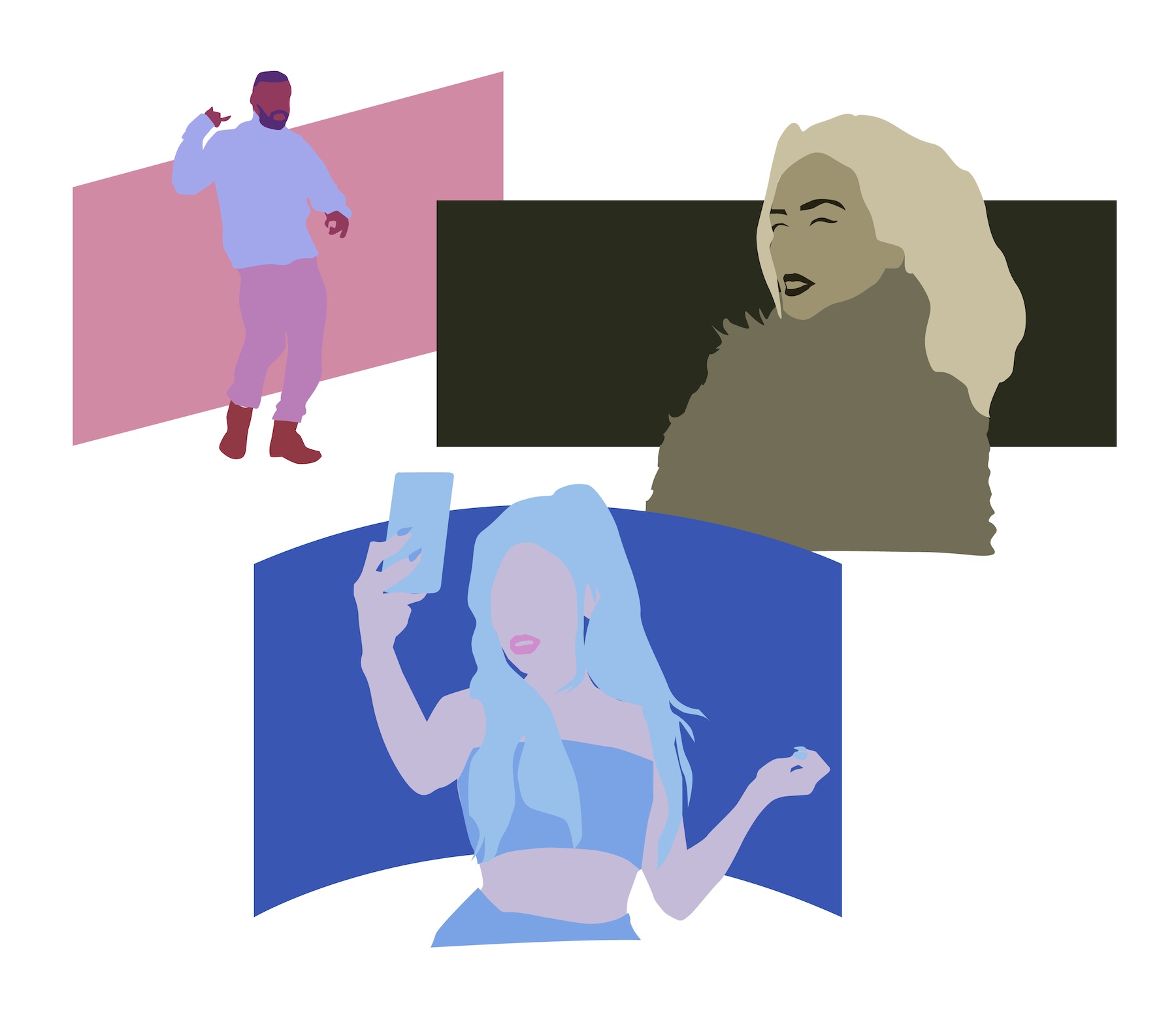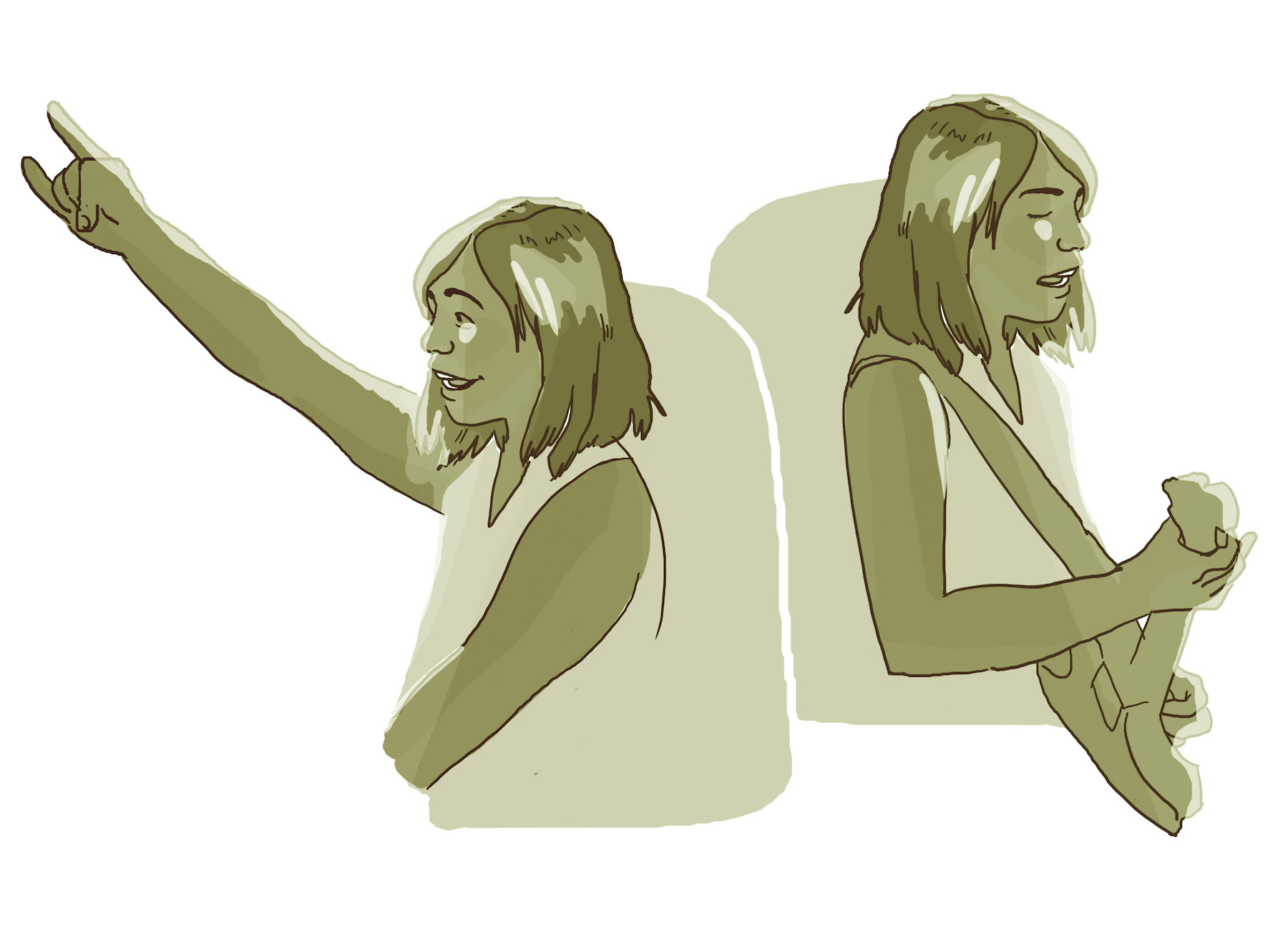As I entered the gallery at Iceberg Projects, I was immediately struck by Barbara DeGenevieve’s presence as she stared at me from a large, black and white photograph across the room. A whiteknuckled fist peeked around a wad of silvery hair in a photograph to my left. Next to it, the writing on the wall said, “I realize the impact this will have. But I can’t stop, I’m too far gone, forgive me.”
Inside “Medusa’s Cave” — DeGenevieve’s posthumous exhibition — presents poetic, disquieting imagery that stir emotions. In the next room, cartoonish drawings of a skull and a set of white, jagged teeth hang side by side. Fragments of handwritten text and hundreds of photocopies of a woman’s eyes repeat in each picture. I learned from Madison Brotherton, DeGenevieve’s former studio manager, that the text in these pieces came from the suicide note that hung next to DeGenevieve’s portrait in the first room. The note and the woman’s eyes both belonged to her mother.
In the series titled “Cliche Verres,” surreal images of DeGenevieve’s face, her mother’s eyes, body organs, distant mountains, and Michelangelo’s “Creation of Adam” hover unsettlingly over dark, murky landscapes. Above, a sadomasochist dialogue appears in gray text across three black panels: “Take the blindfold off. I want to watch you want me, you say. Your arrogance and voyeuristic request arouse my own exhibitionism.”
The piece, titled “‘I’ and ‘You,’” marks a pivotal shift in DeGenevieve’s work — by veiling the subjects’ identities, she invites analysis and response from multiple vantage points. Sadomasochism is used as a device to pose broader questions about society’s understandings of taboo: Is it defined by the nature of the activity, or who engages in it? While previous works explored loss and identity through personal narrative, this piece is a political statement that requires an audience.
In the film, “The Panhandler Project,” DeGenevieve pays five homeless men $100, gives them a day of meals, new clothes, and a night in a hotel room to pose nude for photographs. While the first sitter, Gordon K. Wooton, relaxes on the bed naked, DeGenevieve explains that her peers would accuse her of exploitation because she asked him to take his clothes off. He responds, “Academically, homeless people are not being misused … If I was being paid $50,000 a year, I’d take my clothes off!” While the project is undoubtedly controversial, it is also light, comical, and human. It speaks to her courage and willingness to risk her reputation to question how we view homeless people in society — certainly not as sexual beings, if we see them at all.
In “Desperado,” DeGenevieve meets Daryle Smith, a charming man who unexpectedly tries to get her into bed. After visible inner deliberation, she switches roles from filmmaker to subject and a whirlwind romance unfolds, dissolving boundaries between the academic behind the camera and her subject, a seemingly less credentialed former truck driver. In an interview featured in the film, DeGenevieve challenges the knee-jerk response to her project. “I want people to see it and react to it. I don’t care what the reaction is. You’re trying to make Daryle into a victim, into an object into whatever it is that’s negative about this relationship that we had. Instead of looking at this as something other than slumming it, that’s where you go. The lowest possible point you can push me to,” she says.
Circling back to the photograph at the entrance of the show, I learned that DeGenevieve’s portrait is missing critical information. It was originally part of the triptych, “You Have a Hole,” compounded by an abstract cityscape and a series of white, Morse code-looking dots on black panels.
Madison Brotherton remarked, “Barbara often said ‘years don’t matter, just titles,’ yet there were no titles in the show. The context [of this piece] is completely slain and it becomes an editorial-looking photograph — handsome, but lacking the substance of the original work. She didn’t make the photograph of herself to be hung that way.”
While Iceberg Projects presents a survey of DeGenevieve’s visual oeuvre, (she was also a writer), the portrait is more of a tribute than it is representative of her practice. Also earlier this fall, Defibrillator Gallery presented “What Would Barbara Do?” a series of DeGenevieve’s films alongside works by former students and others engaged with issues she supported. Performance artist Rashayla Marie Brown, DeGenevieve’s former student at the School of the Art Institute of Chicago and now the school’s current director of student affairs for diversity and inclusion, shared anecdotes with DeGenevieve critical to her thinking about expectations of black women in American society, and then had a conversation about normative dating behaviors with her audience. She even called an ex during the performance (it went to voicemail), and danced to Beyonce’s song, “Grown Woman.”
Both of these shows mark the transitional point in an artist’s career where a community takes on the role of preserving and continuing a legacy. While “Medusa’s Cave” features decades of DeGenevieve’s work honing a practice that uses sexual identity as a platform to confront and expand on larger notions of race, class, and gender, “What Would Barbara Do?” reminds us of the importance of mentorship, of passing along the skills and invaluable insight necessary for continuing social advocacy through art.




